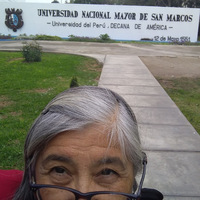Ivonne Bernui Leo
Universidad Nacional Mayor de San Marcos, NUTRICION, Faculty Member
Objectives: To determine the relationship between dietary cholesterol, egg consumption and lipid profile in apparently healthy adults according to age group. Design: Descriptive cross-association study. Setting: Biochemistry and Nutrition... more
Objectives: To determine the relationship between dietary cholesterol, egg consumption and lipid profile in apparently healthy adults according to age group. Design: Descriptive cross-association study. Setting: Biochemistry and Nutrition Research Center, Faculty of Medicine, Universidad Nacional Mayor de San Marcos. Participants: Apparently healthy adults. Interventions: In 50 apparently healthy adults dietary cholesterol consumption, egg and lipid profile were determined. Results: Thirteen participants consumed less than 3 eggs / week, 19 consumed from 3-4 eggs / week and 18 consumed more than 4 eggs / week. The 20-29 year-old group had an average intake of dietary cholesterol (358,9 ± 152,5 mg / dL) significantly higher (p <0,05) than the group 30-39 year-old (223 ± 82, 8 mg / dL). Total cholesterol (chol) of the three groups according to egg consumption was respectively 179,8 ± 52, 168,8 ± 44, and 164,3 ± 62 mg / dL; for HDL-chol 38,9 ± 15 , 28,0 ± 15, and 35,2 ± 14 mg / dL; ...
Research Interests:
Resumen Introducción. La deficiencia de vitamina está siendo considerada como un problema de salud pública. Objetivos. Describir el estatus de la vitamina D en adolescentes del género femenino con obesidad y determinar factores de... more
Resumen Introducción. La deficiencia de vitamina está siendo considerada como un problema de salud pública. Objetivos. Describir el estatus de la vitamina D en adolescentes del género femenino con obesidad y determinar factores de asociación. Diseño. Estudio observacional, descriptivo y analítico. Lugar: Lima Metropolitana. Participantes. Adolescentes mujeres. Intervenciones. Se estudió 111 adolescentes, 58 obesas y 53 no obesas, de acuerdo al índice de masa corporal. Se llevó a cabo una encuesta de alimentos dirigida a aquellos que proporcionaran vitamina D y se identificó los suplementos vitamínicos. Se les midió la circunferencia de la cintura y se tomó la presión arterial. Se les hizo dosaje en sangre venosa de glucosa, perfil lipídico y 25 hidroxivitamina D. El estatus de la vitamina D se determinó con los criterios de Holick. El análisis estadístico se efectuó con las pruebas de t-student, chi cuadrado y ANOVA, con un intervalo de confianza del 95% y un nivel de significancia < 0,05. Principales medidas de resultados. Promedios, intervalos de confianza y prevalencias. Resultados. Se encontró un 10,8% de adolescentes con deficiencia de vitamina D (< 20 ng/mL), 11,3% en las no obesas y 10,3% en las obesas. La ingesta promedio de vitamina D fue de 1,8 ug (IC 1,4 a 2,2) en las no obesas y 1,7 ug (IC 1,4 a 2,1) en las obesas. Mientras que en los deficientes la ingesta fue 2,3 ug (IC 1,9 a 2,9) y 1,7 ug (IC 1,4 a 2) en los no deficientes. No hubo asociación entre la vitamina D y los factores de riesgo cardiovascular. Conclusiones. Una de cada 10 adolescentes presentó deficiencia de vitamina D y dos de cada 10 insuficiencia. Palabras clave. Vitamina D; Adolescentes; Obesidad. Abstract Introduction. Vitamin deficiency is being considered a public health problem. Objectives. To describe vitamin D status in female adolescents with obesity. Design. Observational, descriptive, analytical study. Location. Metropolitan Lima. Participants. Teenagers. Interventions. According to body mass index, 111 adolescents were studied, 58 were obese and 53 non-obese. A food survey was performed including those containing vitamin D and vitamin supplements. Waist circumference and blood pressure were obtained. Glucose, lipid profile and 25 hydroxyvitamin D were determined in serum. Vitamin D status was determined by Holick criteria. Statistical analysis used student-t test, chi-square and ANOVA, with a 95% confidence interval and a significance level of <0.05. Main outcome measures. Averages, confidence interval and prevalence. Results. Vitamin D deficiency (<20 ng/mL) was found in 10.8% of adolescents, 11.3% in non-obese and 10.3% in the obese. Average vitamin D intake was 1.8 ug (95% IC 1.4-2.2) in non-obese and 1.7 ug (95% IC 1.4-2.1) in the obese. Intake was 2.3 ug (95% IC 1.9-2.9) in those deficient and 1.7 ug (95% CI 1.4-2) in the non-deficient. There was no association between vitamin D and cardiovascular risk factors. Conclusions. One out of each 10 adolescent women was vitamin D deficient and 2 of 10 had insufficient vitamin D.
